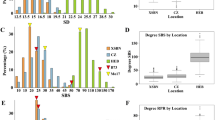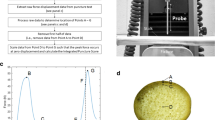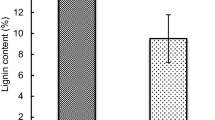Abstract
Stalk bending strength (SBS) is a reliable indicator for evaluating stalk lodging resistance of maize plants. Based on biomechanical considerations, the maximum load exerted to breaking (F max), the breaking moment (M max) and critical stress (σ max) are three important parameters to characterize SBS. We investigated the genetic architecture of SBS by phenotyping F max, M max and σ max of the fourth internode of maize plants in a population of 216 recombinant inbred lines derived from the cross B73 × Ce03005 evaluated in four environments. Heritability of F max, M max and σ max was 0.81, 0.79 and 0.75, respectively. F max and σ max were positively correlated with several other stalk characters. By using a linkage map with 129 SSR markers, we detected two, three and two quantitative trait loci (QTL) explaining 22.4, 26.1 and 17.2 % of the genotypic variance for F max, M max and σ max, respectively. The QTL for F max, M max and σ max located in adjacent bins 5.02 and 5.03 as well as in bin 10.04 for F max were detected with high frequencies in cross-validation. As our QTL mapping results suggested a complex polygenic inheritance for SBS-related traits, we also evaluated the prediction accuracy of two genomic prediction methods (GBLUP and BayesB). In general, we found that both explained considerably higher proportions of the genetic variance than the values obtained in QTL mapping with cross-validation. Nevertheless, the identified QTL regions could be used as a starting point for fine mapping and gene cloning.
Similar content being viewed by others
Abbreviations
- SBS:
-
Stalk bending strength
- RPR:
-
Rind penetrometer resistance
- NIRS:
-
Near-infrared reflectance spectroscopy
- FIAG:
-
The fourth internode above ground
- F max :
-
The maximum load exerted to breaking
- M max :
-
Breaking moment
- σ max :
-
Critical stress
- Ld:
-
Larger diameter of cross section
- Sd:
-
Smaller diameter of cross section
- InL:
-
Internode length
- FreW:
-
Fresh weight of the internode
- DryW:
-
Dry weight of the internode
- InW:
-
Internode water content
- FreW/V:
-
Fresh weight of internode per unit volume
- DryW/V:
-
Dry weight of internode per unit volume
- ADL/V:
-
Acid detergent lignin content per unit volume
- CEL/V:
-
Cellulose content per unit volume
References
Appenzeller L, Doblin M, Barreiro R, Wang H, Niu X, Kollipara K, Carrigan L, Tomes D, Chapman M, Dhugga KS (2004) Cellulose synthesis in maize: isolation and expression analysis of the cellulose synthase (CesA) gene family. Cellulose 11:287–299
Bai Q (2005) Inheritance of stover quality traits and their determination by near-infrared reflectance spectroscopy (NIRS) in silage maize. Dissertation, China Agricultural University
Bohn M, Groh S, Khariallah MM, Hoisington DA, Utz HF, Melchinger AE (2001) Re-evaluation of the prospects of marker-assisted selection for improving insect resistance to Diatraea spp. in tropical maize by cross validation and independent validation. Theor Appl Genet 103:1059–1067
Broman KW, Sen S (2009) A Guide to QTL Mapping with R/qtl. Springer
Charcosset A, Gallais A (1996) Estimation of the contribution of quantitative trait loci (QTL) to the variance of a quantitative trait by means of genetic markers. Theor Appl Genet 93:1193–1201
Ching A, Rafalski JA, Luck S, Butruilie MG (2010) Genetic loci associated with mechanical stalk strength in maize. United States Patent Publication. No. US2010/0015623A1
Colbert TR, Darrah LL, Zuber MS (1984) Effect of recurrent selection for stalk crushing strength of agronomic characteristics and soluble stalk solids in maize. Crop Sci 24:473–478
Doerge RW, Churchill GA (1996) Permutation tests for multiple loci affecting a quantitative character. Genetics 142:285–294
Flint-Garcia SA, Jampatong C, Darrah LL, Mcmullen MD (2003) Quantitative trait locus analysis of stalk strength in four maize populations. Crop Sci 43:13–22
Gao M, Guo K, Yang Z, Li X (2003) Study on mechanical properties of corn stalk. Trans CSAM 34:47–49
Gere JM, Timoshenko SP (1984) Mechanics of Materials. Van Nostrand Reinhold Company Ltd, New York
Gou L, Huang J, Zhang B, Li T, Sun Y, Zhao M (2007) Effect of population density on stalk lodging resistant mechanism and agronomic characteristics of maize. Acta Agronomica Sinia 33:1688–1695
Haley CS, Knott SA (1992) A simple regression method for mapping quantitative trait loci in line crosses using flanking markers. Heredity 69:315–324
Hallauer AR, Carena MJ, Miranda Filho JB (2010) Quantitative Genetics in Maize Breeding. Springer, New York
Hansey CN, Leon N (2011) Biomass yield and cell wall composition of corn with alternative morphologies planted at variable densities. Crop Sci 51:1005–1015
Hu H, Meng Y, Wang H, Liu H, Chen S (2012) Identifying quantitative trait loci and determining closely related stalk traits for rind penetrometer resistance in a high-oil maize population. Theor Appl Genet 124:1439–1447
Jannink J, Lorenz AJ, Iwata H (2010) Genomic selection in plant breeding: from theory to practice. Brief Funct Genomics 9:166–177
Jansen RC, Stam P (1994) High resolution of quantitative traits into multiple loci via interval mapping. Genetics 136:1447–1455
Jia Z, Bai Y (1992) Study on identification of lodging in maize inbred line. China seeds 3:30–32
Kärkkäinen H, Sillanpää M (2012) Back to basics for Bayesian model building in genomic selection. Genetics 191:969–987
Kokubo A, Kuraishi S, Sakurai N (1989) Culm strength of barley correlation among maximum bending stress, cell wall dimensions, and cellulose content. Plant Physiol 91:876–882
Kokubo A, Sakurai N, Kuraishi S, Takeda K (1991) Culm brittleness of barley (Hordeum vulgare L.) mutants is caused by smaller number of cellulose molecules in cell wall. Plant Physiol 97:509–514
Lande R, Thompson R (1990) Efficiency of marker-assisted selection in the improvement of quantitative traits. Genetics 124:743–756
Lauer J (1995) High-Oil Corn: advantages and risks. Field Crops 28.31–3
Li Y, Qian Q, Zhou Y, Yan M, Sun L, Zhang M, Fu Z, Wang Y, Han B, Pang X, Chen M, Li J (2003) BRITTLE CULM1, which encodes a COBRA-like protein, affects the mechanical properties of rice plants. Plant Cell 15:2020–2031
Lorenz AJ, Chao S, Asoro FG, Heffner EL, Hayashi T, Iwata H, Smith HI, Sorrells ME, Jannink JL (2011) Genomic selection in plant breeding: knowledge and prospects. Adv Agron 110:77–123
Ma Q (2009) The expression of caffeic acid 3-O-methyltransferase in two wheat genotypes differing in lodging resistance. J Exp Botany 60:2763–2771
Melchinger AE, Utz HF, Piepho HP, Zeng Z, Schön CC (2007) The role of epistasis in the manifestation of heterosis: a system-oriented approach. Genetics 177:1815–1825
Meuwissen TH, Hayes BJ, Goddard M (2001) Prediction of total genetic value using genome-wide dense marker maps. Genetics 157:1819–1829
Mode CJ, Robinson HF (1959) Pleiotropism and the genetic variance and covariance. Biometrics 15:518–537
Ordas B, Malvar R, Santiago R, Butron A (2010) QTL mapping for Mediterranean corn borer resistance in European flint germplasm using recombinant inbred lines. BMC Genomics 11:174–183
Papst C, Bohn M, Utz HF, Melchinger AE, Klein D, Eder J (2004) QTL mapping for European corn borer resistance (Ostrinia nubilalis Hb.), agronomic and forage quality traits of testcross progenies in early-maturing European maize (Zea mays L.) germplasm. Theor Appl Genet 108:1545–1554
Piepho H-P, Mohring J, Schulz-Streek T, Ogutu JO (2012) A stage-wise approach of the analysis of multi-environment trials. Biometrical J 00:1–17
SAS Institute Inc (2008) SAS user’s guide, version9.2. SAS institute Cary, NC
Schwarz G (1978) Estimating the dimension of a model. Ann Stat 6:461–464
Shenk JS, Westerhaus MO (1991) Population structuring of near infrared spectra and modified partial least square regression. Crop Sci 31:1548–1555
Sibale EM, Darrah LL, Zuber MS (1992) Comparison of two rind penetrometers for measurement of stalk strength in maize. Maydica 37:111–114
Stojsin R, Ivanovic M, Kojic L, Stojsin D (1991) Inheritance of grain yield and several stalk characteristics significant in resistance to stalk lodging maize (Zea mays L.). Maydica 36:75–81
Sun X (1987) Studies on the resistance of the culms of rice to lodging. Scientia Agricultura Scinica 20:32–37
R Core Team (2012) R: a language and environment for statistical computing. R Foundation for Statistical Computing, Vienna, Austria. ISBN 3-900051-07-0, http://www.R-project.org/
Technow F, Melchinger AE (2013) Genomic prediction of dichotomous traits with Bayesian logistic models. Theor Appl Genet 126:1133–1143
Technow F, Bürger A, Melchinger AE (2013) Genomic prediction of northern corn leaf blight resistance in maize with combined or separated training sets for heterotic groups. G3 3:197–203
Thompson DL (1963) Stalk strength of corn as measured by crushing strength and rind thickness. Crop Sci 3:323–329
Utz HF (2010) PLABSTAT: a computer program for statistical analysis of plant breeding experiments. Institute of Plant Breeding, Seed Science, and Population Genetics, University of Hohenheim, Stuttgart, Germany
Utz HF, Melchinger AE, Schön CC (2000) Bias and sampling error of the estimated proportion of genotypic variance explained by quantitative trait loci determined from experimental data in maize using cross validation and validation with independent samples. Genetics 154:1839–1849
Wang H (2009) QTL analysis and genetic relationship between kernel compositions and stalk nutrition quality traits in high oil maize population. Dissertation, China Agricultural University
Wang J, Li H, Zhang L, Li C, Meng L (2010) Users’ Manual of QTL IciMapping V3.0, Beijing
Würschum T, Liu W, Gowda M, Maurer HP, Fischer S, Schechert, Reif JC (2012) Comparison of biometrical models for joint linkage association mapping. Heredity 108:332–340
Xu S (2008) Quantitative trait locus mapping can benefit from segregation distortion. Genetics 180:2201–2208
Yuan Z, Feng B, Zhao A, Liang A (2002) Dynamic analysis and comprehensive evaluation of crop-stem lodging resistance. Trans CSAE 18(6):30–31
Zeng Z (1994) Precision mapping of quantitative trait loci. Genetics 136:1457–1468
Zhang L, Wang S, Li H, Deng Q, Zheng A, Li S, Li P, Li Z, Wang J (2010) Effects of missing marker and segregation distortion on QTL mapping in F2 populations. Theor Appl Genet 121:1071–1082
Zuber MS, Grogan CO (1961) A new technique for measuring stalk strength in corn. Crop Sci 1:378–380
Zuber MS, Colbert TR, Bauman LF (1977) Effect of brown-midrib-3 mutant in maize (Zea mays) on stalk strength. Z Pflanzenzuecht 79:310–314
Zuber MS, Colbert TR, Darrah LL (1980) Effect of recurrent selection for crushing strength on several stalk components in maize. Crop Sci 20:711–717
Acknowledgments
We thank Lianying Yu, Baohua Liu and Yan Luo of China Agricultural University for their help in the three-point bending test. We also thank H. Fritz Utz, Tobias Schrag and Xuefei Mi for their suggestions on the data analysis. This research was supported by grants from the Modern Maize Industry Technology System Foundation of China (No. nycytx-02) to S. Chen, DFG, Grant No. 1070/1, International Research Training Group “Sustainable Resource Use in North China” to A.E. Melchinger and National Natural Science Foundation of China (No. 10972234) to Z. Fu.
Author information
Authors and Affiliations
Corresponding authors
Additional information
Communicated by N. de Leon.
H. Hu and W. Liu contributed equally to this work.
Electronic supplementary material
Below is the link to the electronic supplementary material.
Rights and permissions
About this article
Cite this article
Hu, H., Liu, W., Fu, Z. et al. QTL mapping of stalk bending strength in a recombinant inbred line maize population. Theor Appl Genet 126, 2257–2266 (2013). https://doi.org/10.1007/s00122-013-2132-7
Received:
Accepted:
Published:
Issue Date:
DOI: https://doi.org/10.1007/s00122-013-2132-7




